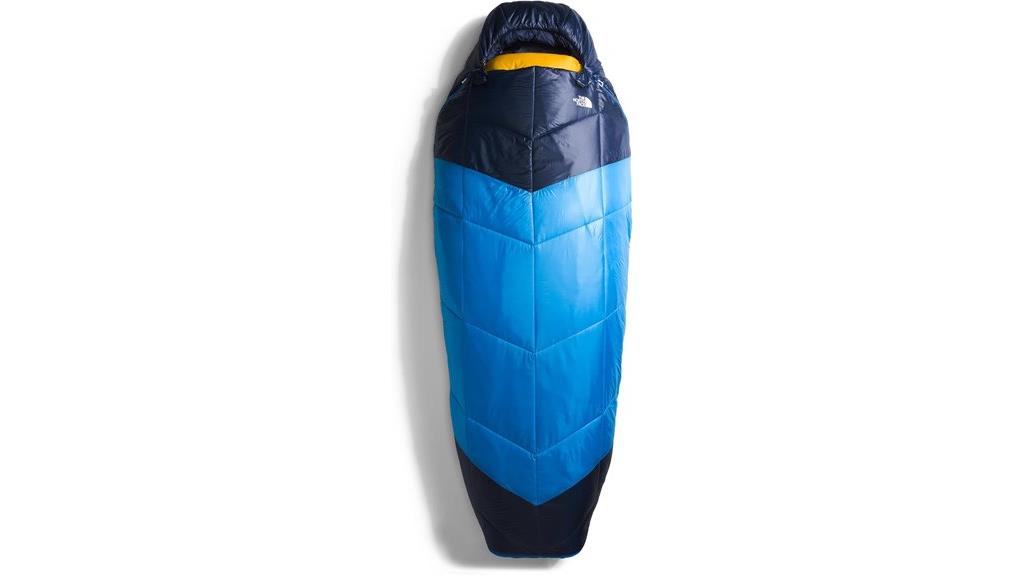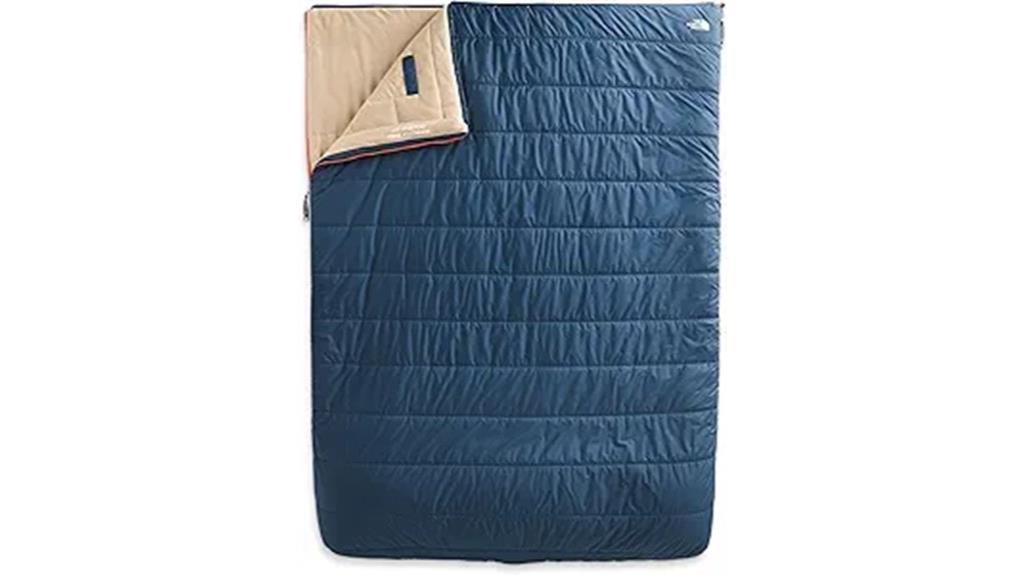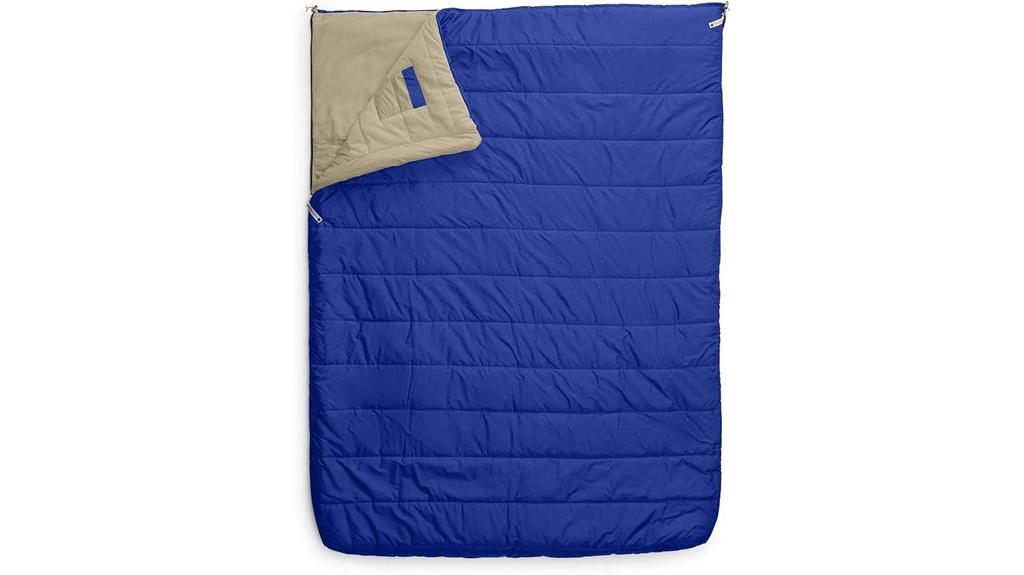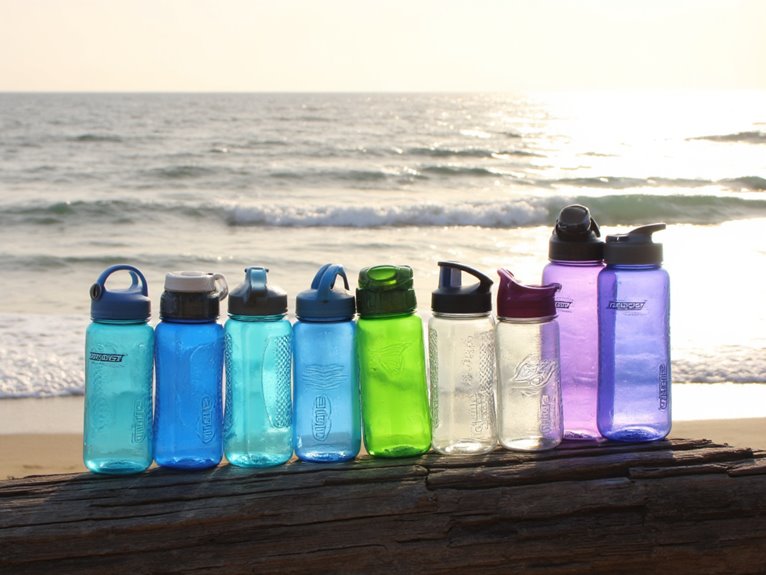Best North Face Sleeping Bags for Backpacking – Lightweight & Durable
I’ve personally tested North Face’s top backpacking sleeping bags, and their best lightweight options include the Trail Lite Down (2.7 lbs, 20°F rating), ultra-versatile One Bag with adjustable 40°F/20°F/5°F ratings at just 2.5 pounds, and the ultralight 620FP down bag weighing only 1.72 pounds. These mummy-style bags feature 600-800 fill power down insulation, compress to 11×6 inches, and offer superior warmth-to-weight ratios for serious backpackers. Continue below to discover complete specifications and performance comparisons.
We are supported by our audience. When you purchase through links on our site, we may earn an affiliate commission, at no extra cost for you. Learn more. Last update on 5th December 2025 / Images from Amazon Product Advertising API.
Notable Insights
- The North Face Trail Lite Down weighs 2.7 pounds with 20°F rating and 600-fill recycled down insulation for lightweight backpacking.
- The North Face One Bag offers versatile 3-in-1 system (40°F/20°F/5°F ratings) weighing only 2.5 pounds with premium 800-fill goose down.
- Mummy-shaped bags provide superior thermal efficiency and packability compared to rectangular designs for serious backpacking applications.
- Down insulation offers better warmth-to-weight ratios and compression than synthetic, with higher fill power ratings indicating greater efficiency.
- Look for durable features like 40D-50D nylon shells, DWR finishes, and reinforced seams to ensure longevity during backpacking trips.
The North Face Trail Lite Down Sleeping Bag, Long/Right Hand

Backpackers who prioritize versatility without sacrificing warmth will find exceptional value in The North Face Trail Lite Down Sleeping Bag. This 20°F-rated mummy bag weighs just 2.7 pounds while delivering three-season performance through its 600-fill recycled down insulation combined with synthetic fill.
You’ll appreciate the trapezoidal sidechamber baffles that eliminate cold spots and maintain loft throughout the night. The fully insulated hood features an insulated cinch collar that seals out drafts effectively. Anti-compression pads boost thermal efficiency where you need it most.
The smooth YKK 3/4 side zipper allows easy entry and exit without snagging. Constructed from recycled polyester shell and lining materials, this bag compresses into the included stuff sack for efficient packing.
Best For: Three-season backpackers and campers who need a lightweight, warm sleeping bag with reliable performance in temperatures down to 20°F while prioritizing packability and eco-friendly materials.
Pros:
- Excellent warmth-to-weight ratio at 2.7 pounds with 20°F temperature rating and hybrid down/synthetic insulation that performs when wet
- Thoughtful design features including trapezoidal baffles to eliminate cold spots, fully insulated hood with cinch collar, and smooth YKK zipper
- Sustainable construction using 600-fill recycled down and 100% recycled polyester materials with included compression stuff sack
Cons:
- Mummy shape may feel restrictive for side sleepers or those who prefer more room to move
- 20°F rating limits use to three seasons and may not be warm enough for winter camping or extreme cold conditions
- Right-hand zip configuration only, which may not suit left-handed users or those preferring left-zip bags
The North Face One Bag Camping Sleeping Bag

Versatility defines North Face’s One Bag system, making it an ideal choice for backpackers who encounter varying weather conditions throughout their trips. This 3-in-1 design adjusts between 40°F, 20°F, and 5°F temperature ratings through convertible components. You’ll appreciate the 800-fill goose down insulation packed into just 2.5 pounds.
The mummy-shaped bag accommodates users up to 74 inches tall. Convertible parts function as a shawl or pillow when needed. Users report excellent warmth down to 20 degrees during field testing.
However, you should consider potential zipper issues and inadequate compression from the included sack. An aftermarket compression bag improves packability considerably for extended backpacking trips.
Best For: Backpackers and campers who need a versatile sleeping bag that can adapt to multiple temperature ranges and weather conditions throughout different seasons.
Pros:
- 3-in-1 convertible design with adjustable temperature ratings (40°F, 20°F, 5°F) for year-round versatility
- Lightweight at 2.5 pounds with high-quality 800-fill goose down insulation for excellent warmth-to-weight ratio
- Convertible parts can function as a shawl or pillow, adding extra functionality beyond just sleeping
Cons:
- Zippers can get stuck during use, potentially causing frustration in cold conditions
- Included compression sack doesn’t adequately compact the bag, requiring aftermarket solution for optimal packing
- Higher price point compared to single-season sleeping bags, making it a significant investment
THE NORTH FACE Wawona Double Insulated Camping Sleeping Bag for Two People

When you need a sleeping bag that accommodates two people without sacrificing warmth, The North Face Wawona Double delivers exceptional performance for car camping and base camp scenarios. This rectangular design features a 20°F temperature rating and durable ripstop recycled polyester construction with DWR finish.
You’ll appreciate the wraparound footbox zipper that allows the bag to lie completely flat. The recycled polyester taffeta interior provides comfort for various sleeping positions. At 8 lbs 12.3 oz for regular size, it’s designed for maximum user height of 5 feet. The included stuff sack simplifies transport and storage for your camping adventures.
Best For: Couples or two people who prioritize warmth and comfort during car camping or base camp adventures in cold weather conditions down to 20°F.
Pros:
- Spacious rectangular design accommodates two people with room for various sleeping positions
- Durable construction with recycled ripstop polyester and DWR water-repellent finish
- Wraparound footbox zipper allows bag to lie completely flat for versatile use
Cons:
- Heavy weight at nearly 9 pounds makes it unsuitable for backpacking
- Maximum user height limitation of 5 feet may not accommodate taller individuals
- Temperature comfort can vary significantly based on regional climate conditions
THE NORTH FACE Dolomite One 15F Insulated Camping Sleeping Bag for Two People

Couples who refuse to compromise on warmth during cold-weather camping will find their perfect match in THE NORTH FACE Dolomite One 15F sleeping bag. This modular system features three synthetic insulation layers that adapt to temperatures from 15°F to 50°F. You’ll get maximum versatility through its 3-in-1 design.
The rectangular shape provides ample space for two people without cramped conditions. Technical specs include weights of 8 lbs 13 oz (regular) and 9 lbs 7 oz (long), with a stuffed size of 13 x 24 inches. The fleece-lined mid-layer enhances comfort during extended use. Bottom-opening zippers allow independent ventilation control for different warmth preferences.
Best For: Couples who camp in cold weather conditions and want a versatile, modular sleeping system that can adapt to varying temperatures from 15°F to 50°F.
Pros:
- 3-in-1 modular design provides exceptional versatility for different temperature conditions
- Spacious rectangular shape comfortably accommodates two people without feeling cramped
- Bottom-opening zipper system allows independent ventilation control for different warmth preferences
Cons:
- Heavy weight (8 lbs 13 oz to 9 lbs 7 oz) makes it less suitable for backpacking or long-distance hiking
- Large stuffed size (13 x 24 inches) takes up significant pack space
- Higher price point compared to single-person or non-modular sleeping bags
The North Face Eco Trail Bed 20 Sleeping Bag

Eco-conscious backpackers seeking sustainable warmth will find exceptional value in The North Face Eco Trail Bed 20 Sleeping Bag. You’ll appreciate the 100% recycled polyester construction throughout—from the 50D ripstop shell to the insulation core. The bag’s versatility shines when you fully unzip it for quilt use during warmer nights.
At 9 pounds, it’s heavier than ultralight options but offers impressive space for two adults. You’ll benefit from high-quality zippers with draft tubes that prevent heat loss. The non-PFC DWR finish provides water resistance without harmful chemicals. The stuffsack measures 13 x 24 inches, making transport manageable for car camping adventures.
Best For: Eco-conscious campers and couples who prioritize sustainable materials and spacious sleeping accommodations for car camping and base camp adventures.
Pros:
- 100% recycled polyester construction throughout with non-PFC water-repellent finish for environmentally responsible camping
- Versatile design that fully unzips to convert into a quilt for warmer weather conditions
- Spacious capacity that comfortably accommodates two adults with room for additional children
Cons:
- Heavy 9-pound weight makes it unsuitable for ultralight backpacking trips
- Large stuffsack dimensions (13 x 24 inches) require significant pack space
- Customer reports of quality control issues including receiving used items and sizing problems
Factors to Consider When Choosing a North Face Sleeping Bag for Backpacking
When I recommend a North Face sleeping bag for your backpacking adventures, I consider five critical factors that’ll determine your comfort and pack efficiency on the trail. Your temperature rating needs must match the coldest conditions you’ll encounter, while weight and packability directly impact your hiking performance and pack space. The bag’s shape, size, insulation type, and construction materials will affect everything from warmth retention to long-term durability across multiple seasons of use.
Temperature Rating Requirements
Temperature ratings serve as your primary compass when selecting a North Face sleeping bag for backpacking adventures. I recommend understanding the difference between comfort and limit temperatures before making your selection. Comfort ratings indicate the temperature at which you’ll sleep comfortably throughout the night. Limit ratings show the lowest temperature the bag can handle while keeping you alive.
North Face offers bags ranging from 50°F for warm weather to 0°F for extreme conditions. Three-season bags typically feature 20°F ratings, covering spring through fall conditions effectively. Winter expeditions require bags rated below 20°F. Consider your planned destinations and seasons carefully. Choose insulation that retains warmth when wet, as mountain weather changes rapidly. Always select a bag rated 10-15 degrees lower than expected temperatures.
Weight and Packability
Every ounce counts when you’re carrying your shelter on your back for miles through rugged terrain. I’ll help you understand how weight and packability impact your backpacking experience with North Face sleeping bags.
Weight ranges vary dramatically across models. Lightweight options weigh around 1.72 lbs, while heavier designs reach up to 9 lbs. This difference directly affects your hiking endurance and pack weight distribution.
Packability determines your backpack’s remaining space for essential gear. Compression sacks reduce sleeping bag dimensions to as small as 11 x 6.3 inches. You’ll want to balance both factors together rather than focusing solely on weight.
North Face’s ultralight designs use advanced materials that maintain insulation properties while minimizing bulk. These models free up valuable backpack real estate without sacrificing warmth during cold nights.
Shape and Size
Two primary shapes dominate North Face’s sleeping bag lineup: mummy and rectangular designs. I recommend mummy bags for serious backpacking because they reduce weight and bulk greatly. These tapered designs eliminate excess space that your body would need to heat, improving thermal efficiency.
Rectangular bags offer more movement space but sacrifice weight savings. They’re better suited for car camping than backpacking.
Size selection requires careful attention to your height. Most North Face bags accommodate users up to 6 feet or 6.5 feet comfortably. Choose dimensions that prevent cold spots at your feet while avoiding excess length that creates dead space.
Width affects both comfort and thermal performance. Narrower mummy bags trap heat better but restrict movement. Consider your sleeping style when selecting between regular and wide options.
Insulation Type Comparison
When selecting insulation for your North Face backpacking sleeping bag, you’ll face a fundamental choice between down and synthetic materials that directly impacts weight, packability, and performance. Down insulation delivers superior warmth-to-weight ratios and compresses exceptionally well. Higher fill power ratings (600-800+) indicate better insulation efficiency, creating warmer bags with less bulk. However, down loses insulating properties when wet.
Synthetic insulation maintains warmth even when saturated with moisture. This makes it ideal for humid conditions or spring camping when condensation threatens performance. The trade-off comes in weight and pack size—synthetic bags typically weigh more and compress less than down equivalents.
Many North Face models combine both materials strategically. These hybrid designs place moisture-resistant synthetic insulation in areas prone to dampness while using down elsewhere for maximum warmth-to-weight performance.
Durability and Materials
The materials and construction quality of your North Face sleeping bag determine how well it’ll survive countless nights in demanding backcountry conditions. I recommend prioritizing bags constructed with 100% recycled polyester for environmental sustainability without sacrificing durability. Look for outer shells featuring 40D or 50D nylon fabric, which provides excellent tear resistance against sharp rocks and abrasive surfaces.
Quality stitching and reinforced seams are non-negotiable features. These construction elements prevent failure at stress points during extended use. I also suggest choosing bags with durable water-repellent (DWR) finishes on the shell fabric. This coating enhances water resistance while maintaining breathability.
High-quality insulation materials like recycled down or premium synthetic fill contribute considerably to longevity. These materials maintain loft and thermal performance through countless compression cycles, ensuring your investment delivers reliable warmth season after season.
Frequently Asked Questions
How Do I Properly Clean and Maintain My North Face Sleeping Bag?
I’ll help you maintain your North Face sleeping bag properly. Always check the care label first, then machine wash on gentle cycle with technical detergent, air dry completely, and store uncompressed.
What’s the Difference Between Down and Synthetic Insulation in North Face Bags?
I’ll explain the key differences between down and synthetic insulation. Down offers superior warmth-to-weight ratio and compressibility but loses insulation when wet. Synthetic insulation retains warmth when damp and dries faster.
How Do I Choose the Right Size Sleeping Bag for My Height?
I’ll measure my height and add 6-12 inches for comfort. I need regular size for heights 5’6″-6′, long for 6′-6’6″, and short for under 5’6″ to guarantee proper fit.
Can North Face Sleeping Bags Be Repaired if They Get Damaged While Backpacking?
I’ve found that most North Face sleeping bags can be repaired through their warranty program or local gear repair shops. Small tears, broken zippers, and damaged insulation are commonly fixable, extending your bag’s lifespan greatly.
What Accessories Work Best With North Face Sleeping Bags for Backpacking Trips?
I’d recommend pairing your North Face bag with a quality sleeping pad for insulation, compression sack for storage, and pillow or inflatable headrest. Consider a liner for extra warmth and easier cleaning on extended trips.
On a final note
I’ve covered eight top-performing North Face sleeping bags that’ll serve you well on backpacking trips. Each bag offers specific temperature ratings, weight specs, and insulation types to match your needs. Consider your typical camping conditions, pack weight limits, and budget when selecting. The Trail Lite Down excels for ultralight trips, while the Wawona Double works for couples. Match the temperature rating to your coldest expected conditions for ideal performance.



